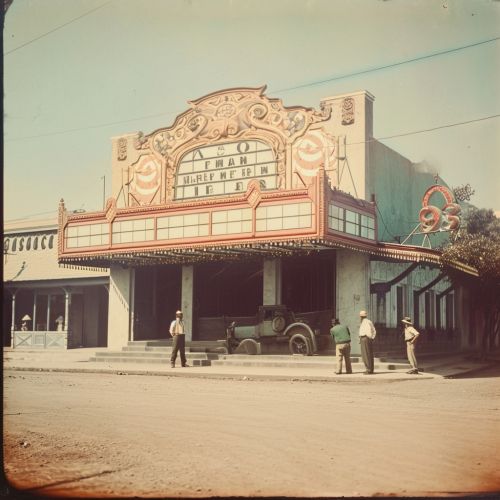Cinema of the United States
History
The American cinema has a long and complex history that dates back to the late 19th century. The first motion picture was patented in 1891 by Thomas Alva Edison, a prolific inventor who played a crucial role in the development of the modern industrialized world. Edison's invention, the Kinetoscope, was a forerunner of the motion picture film projector. It was a peep-show device that allowed one person at a time to watch a short film.


The first public demonstration of motion pictures in the U.S. took place in 1893, when Edison's assistant, William K.L. Dickson, presented a short film titled Blacksmith Scene. This marked the beginning of the American film industry, which would soon become the largest and most influential in the world.
The early 20th century saw the rise of the Hollywood studio system, with major studios such as Paramount, Warner Bros., and MGM dominating the industry. These studios produced a wide variety of films, from melodramas and comedies to westerns and musicals, and introduced many of the conventions and genres that still define American cinema today.
The Golden Age of Hollywood
The period from the late 1920s to the early 1960s is often referred to as the Golden Age of American cinema. This era was marked by the emergence of sound in film, the development of color cinematography, and the rise of the star system. It was during this time that Hollywood established itself as the center of the American film industry and became synonymous with American cinema.
The Golden Age was characterized by the dominance of the studio system, in which major studios controlled all aspects of film production and distribution. This system allowed for a high degree of control over the filmmaking process, resulting in a distinctive style and aesthetic that defined American cinema during this period.
New Hollywood and Beyond
The late 1960s and early 1970s marked a significant shift in American cinema, with the emergence of a new generation of filmmakers known as the New Hollywood generation. These filmmakers, including directors such as Martin Scorsese, Francis Ford Coppola, and Steven Spielberg, brought a fresh and innovative approach to filmmaking, challenging the conventions of the studio system and pushing the boundaries of cinematic storytelling.
The New Hollywood era was followed by the rise of the blockbuster in the late 1970s and 1980s, with films such as Star Wars and Jaws setting new records for box office revenue. This trend towards high-concept, high-budget films has continued into the 21st century, with the emergence of the superhero genre and the dominance of franchises such as the Marvel Cinematic Universe and the Star Wars series.
Impact and Influence
The impact and influence of American cinema can be seen in various aspects of culture and society, from fashion and music to politics and technology. American films have shaped global perceptions of the U.S. and have played a significant role in spreading American culture and values around the world.
American cinema has also had a profound influence on the development of film as an art form, introducing innovative techniques and technologies, pioneering new genres and styles, and producing some of the most critically acclaimed and commercially successful films in the history of cinema.
